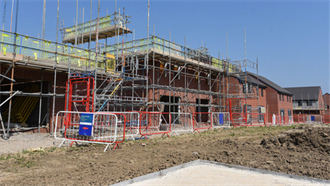EY's Dietmar Klos and Mark Grinis examine the evolving real estate landscape in 2024 and discuss how investors can navigate the numerous challenges and opportunities which have emerged.
Geopolitical events and regional conflicts have continued to exert their influence on market dynamics, adding an additional layer of complexity. However, amidst these challenges, the opportunity to invest in global real estate remains promising, emphasizing the importance of keeping a long-term perspective.
Facing the storm: real estate’s 2024 challenges unveiled
Key issues such as interest rate uncertainties, inflation, and low deal volumes remain dominant factors that are significantly impacting investor and asset manager strategies. One significant concern is the maturing debt, putting pressure on the credit market.
As we progress into 2024, the real estate market continues to grapple with uncertainty. Transaction activities continue to be slow due to pricing and valuation disparities, while concerns about the resurgence of the non-performing loan market linger in the background.
Amidst this complex environment, there is a notable mismatch in valuation and risk premiums within the market. The unpredictability of construction material prices, exacerbated by geopolitical conflicts, adds to the industry’s challenges. The impact of these challenges is clearly reflected in global real estate transaction volumes.
In 2023, European commercial real estate deal volumes witnessed a stark 50%2 year-over-year decline compared to 2022. In the United States, a similar trend is observed, with a substantial 51% year-over-year decline in investment volume for 2023, followed by a noteworthy recovery, with an anticipated 15%4 increase in 2024.
Shifting tides: finding opportunity amidst real estate’s challenges
As we move into the year, the global real estate sector stands at an intriguing juncture, with multiple factors hinting at positive industry shifts. A significant source of optimism arises from recent monetary policy decisions by central banks, including the Fed and the European Central Bank.
In response to the global inflation surge in 2022, these institutions implemented interest rate hikes. However, by October 2023, the ECB paused rate increases, instilling hope in the market. There remains ongoing demand for residential properties in most of Europe.
To address fixed pricing challenges amid cost uncertainties, some promoters have adopted a “build first, then sell” strategy, allowing for flexible pricing in response to market dynamics. While developers and investors have been cautious, anticipating signals from governments, there’s optimism that such forthcoming resolutions will stimulate the market.
Asset classes are showing price adjustments,6 signaling a potential transaction revival and more debt fund launches are on the rise. Conversations with market participants uncover that expectations point to a surge in deal volumes in late 2024 or early 2025.
Beyond the horizon: the vital role of long-term vision
In the realm of real estate investment, it’s imperative to shift our focus away from short-term fluctuations and embrace a patient, long-term perspective. Investors often hesitate, seeking to time the real estate market perfectly, perhaps reminiscing about historically low interest rates. However, it’s vital to acknowledge the recent bias in such viewpoints. Historical data shows that interest rates have been higher in the past, yet deals continued, and investors thrived.
As Warren Buffett wisely noted, “Be fearful when others are greedy and greedy when others are fearful.” Presently, many in the real estate sector are gripped by fear due to concerns about interest rates and inflation. Real estate investments are akin to marathons, emphasizing the importance of a long-term perspective.
Redefining boundaries: exploring the potential of emerging real estate markets
As we emphasize the importance of long-term thinking, it becomes equally critical to think outside the box and seek opportunities beyond the familiar horizons. A noteworthy vision for the future sees a possible substantial shift in the global economic order by 2075. Projections suggest that China, India, the USA, Indonesia, Nigeria, Pakistan, Egypt, Brazil, Germany, and the UK will dominate the world’s largest economies, potentially reshaping the traditional top 10 ranking.
This tectonic shift underscores the need to explore emerging markets with fresh perspectives today. As of now, a staggering $400 billion of dry powder has been amassed globally for real estate investments,9 and the question arises: where will this capital flow in search of higher yields? Key sources of capital include the United States, Singapore, and Canada. At the same time, investment destinations encompass the United States, the UK, Germany, and prominently feature other European countries.
Notably, an increasing share of capital has flowed into the Asia-Pacific region in recent times. Insights into the competitive real estate market illuminate its dynamics, revealing that a substantial 60% of the world’s institutional real estate value is concentrated in just 40 cities.
Emerging markets may offer a wider landscape, though it is important to note investors have entered this market with mixed success in the past. China, an often-cited case study for emerging markets investment, gained global economic prominence over 40 years from economic reforms, demographic shifts, and strategic decisions like the establishment of Special Economic Zones and WTO entry to encourage outside investment.
As other countries take similar steps to China, investors should adopt a disciplined approach to evaluating investment in emerging markets, and consider factors such as a country’s economic stability, demographics, transparency regulations, local operating partners, investment exit strategies, market demand, and ability to manage risks. Further, the idea that inexpensive labor is the key to emerging economies has been challenged in recent years, emphasizing the importance of upskilling, and transitioning to a knowledge-based economy. While higher risk, emerging markets offer potential for higher returns, making them an attractive frontier for those willing to adapt to evolving economic landscapes.
Sustainability’s mandate: ESG in real estate’s spotlight
It is vital to note that pricing differentials have already emerged between “green” and “brown” projects, and that sustainability-minded real estate has a positive impact on property value. Elevating ESG maturity within the real estate sector is crucial, considering its substantial role in greenhouse gas emissions, accounting for roughly 40% of global emissions.
The role of INREV Sustainability and Reporting guidelines is pivotal in integrating ESG considerations into business operations. Robust monitoring systems and due diligence processes are essential for identifying investment opportunities and managing ongoing investments. Challenges persist, including potential conflicts with investment strategies, resource constraints, and the imperative to bridge the gap between ESG goals and actual performance. A historic moment occurred during COP28 when an agreement was reached to include fossil fuels in the final statement.
In conclusion, the real estate industry in 2024 certainly faces a landscape shaped by challenges and opportunities. While uncertainties persist, opportunities for investment prevail, underpinned by strategic adaptability and a focus on long-term goals. As we move forward, the industry’s resilience, innovation, and commitment to sustainability continue to position real estate as an attractive asset class for institutional capital.
About the authors:
Dietmar Klos is real estate sector leader, EY Luxembourg, and Mark Grinis is real estate, hospitality & construction leader, EY Americas



































